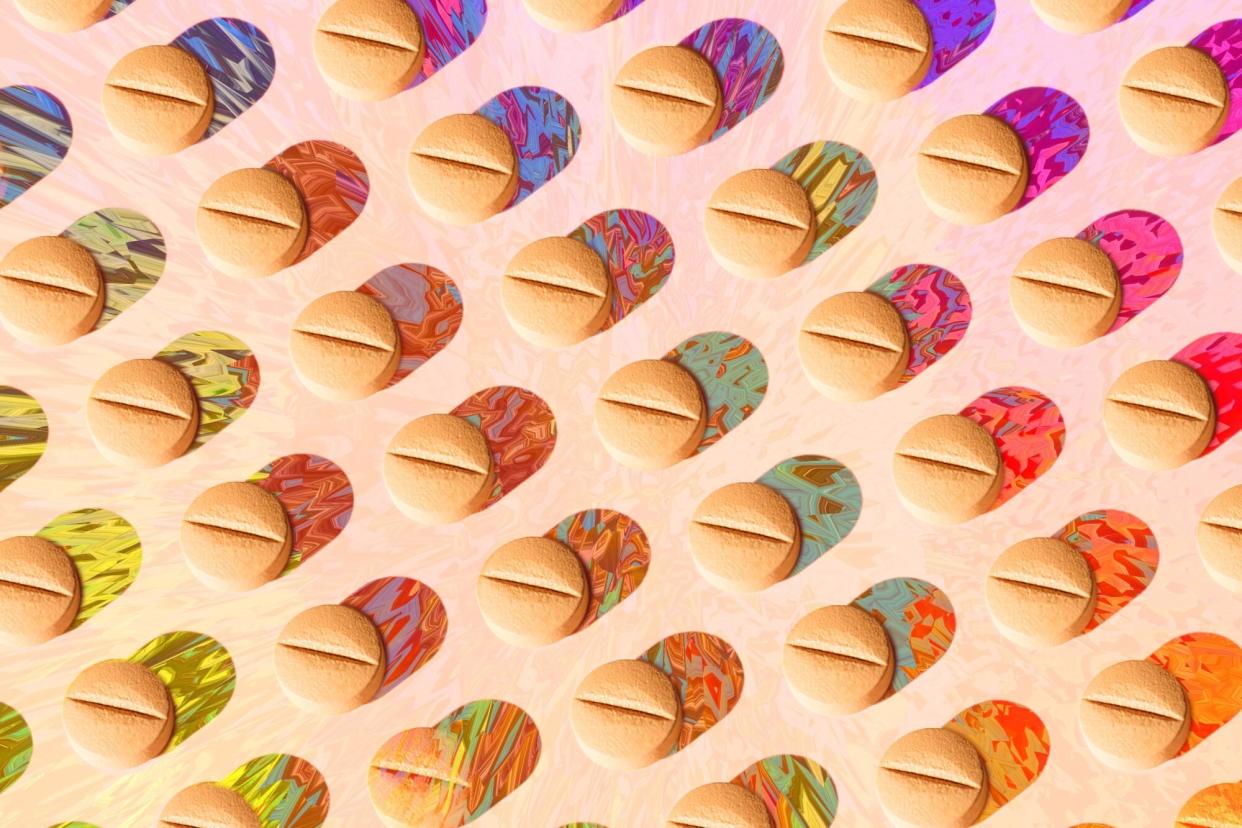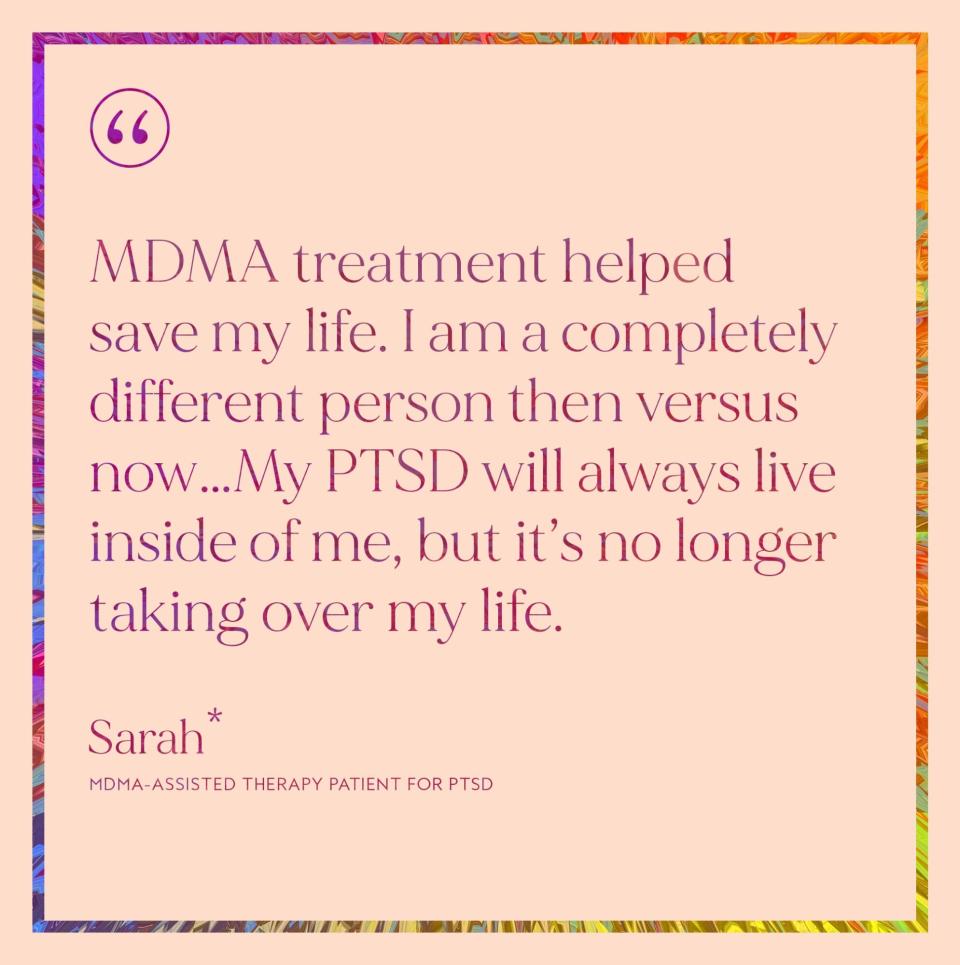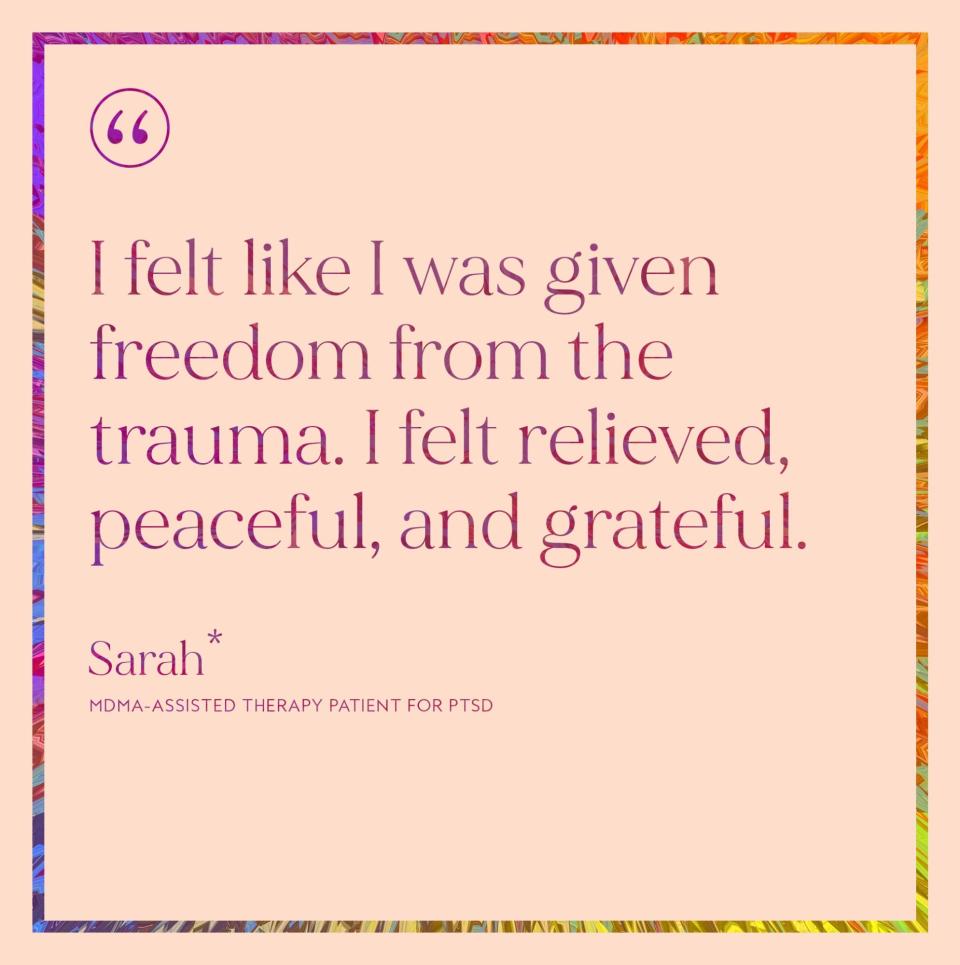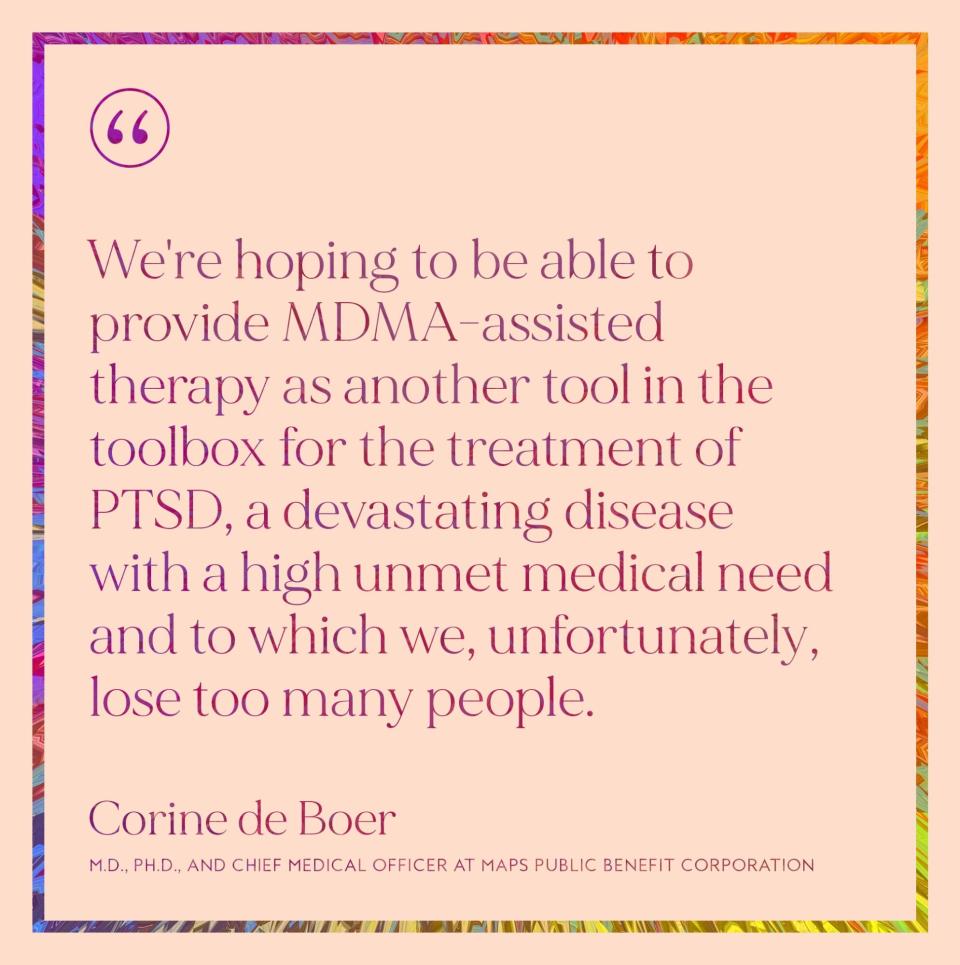"MDMA Treatment Helped Save My Life"

Getty Images, Stocksy/InStyle
Sarah* first noticed that something was wrong five years ago. She would suddenly start crying for no reason, felt unable to manage her workload at her six-figure office job, and even had a panic attack while on a date.
There was an incident that happened to her the year prior, but the details were fuzzy, and she didn't connect it to the symptoms she was experiencing. However, things worsened to the point that Sarah's entire world was turned upside-down, with depression, anxiety, insomnia, loss of focus, and high blood pressure derailing her professional and personal lives.
About seven months later, her therapist diagnosed Sarah with post-traumatic stress disorder (PTSD).
Each year, 15 million Americans are diagnosed with the psychiatric condition, per the National Center for PTSD, suffering from symptoms like sadness; fear; anger; self-imposed isolation; flashbacks and nightmares of the incident; and intense, dark thoughts. About 10% of women will experience PTSD in their lifetime, versus 4% of men, per the National Alliance on Mental Illness.
Those with PTSD — ranging from military veterans to victims of natural disasters to assault victims — can be easily triggered by seemingly normal stimuli, like a loud noise or flashing lights.
After working with her therapist, Sarah realized that her PTSD was rooted in that foggy incident: a traumatic sexual assault that she hadn't fully come to grips with. "I had a lot of blank spots trying to remember what happened, and I wasn't aware of how bad the assault was at the time," she said. "I just wanted to move on and continue my career, but my PTSD gradually got worse and worse."
Desperate to reclaim her life, Sarah tried myriad approaches, including talk therapy, hypnotherapy, medications, eye movement desensitization and reprocessing (EMDR), brainspotting, neurofeedback, somatic therapy, dialectical behavior therapy, mindfulness, art therapy, acupuncture, yoga, fitness, dance, massage, and inpatient and outpatient hospitalization.
But nothing helped. Things got so bad that one day, Sarah had a vivid flashback of the assault while at home and believed her apartment had turned into the scene of the crime. "I saw myself getting sexually assaulted, and it was the first time some of the blank memory spots became clear," she recalls. "I was absolutely terrified — I started screaming and wailing, begging for it to stop."
At that point, her PTSD went from moderate to severe, she says, and she found herself terrified to leave her home and contemplating the most effective form of suicide. Sarah even went so far as to put supplies for her suicide plan into her Amazon cart for purchase. However, she realized she wasn't quite ready to give up. "I was feeling desperate, yet determined to get better," she recalls.
So, as anyone with a medical condition does in the 21st century, Sarah Googled it. She was researching nontraditional forms of PTSD treatment when she discovered the nonprofit Multidisciplinary Association for Psychedelic Studies (MAPS), which was recruiting test subjects for a study of the effects of MDMA — often called ecstasy or molly — on PTSD.

Getty Images, Stocksy/InStyle
Quick background: Small studies of MDMA-assisted therapy began in the early 2000s, says Corine de Boer, M.D., Ph.D., and chief medical officer at MAPS Public Benefit Corporation, a corporate subsidiary of MAPS and its clinical research arm. Then, in 2017, the FDA granted "breakthrough therapy" designation to the treatment, which helps speed the development and review of drugs that treat serious conditions.
RELATED: Why Are Celebrities Smoking Toad Venom?
So three years ago, Sarah gave it a shot, completing a three-month course of three MDMA-assisted therapy sessions, during which a patient takes the drug to confront the traumatic event that caused their disorder.
Finally, she found relief and was eventually able to wean off all her mental health medications. Once paralyzed at the thought of even stepping out her front door, she backpacked solo throughout Bali and Thailand for a year, did some serious soul-searching, and became certified in yoga. She decided to leave the corporate world to become a group fitness instructor and found her soulmate.
Today, the 40-year-old isn't totally cured of her PTSD. Her symptoms may abate for long periods but re-emerge when triggered by, say, an unwelcome sexual advance. Yet, she believes the MDMA-assisted therapy made all the difference.
"The study and the MDMA treatment helped save my life. I am a completely different person then versus now," says Sarah. "My PTSD will always live inside of me, but it's no longer taking over my life."

Sarah isn't alone in finding relief through MDMA-assisted therapy for PTSD. A 2021 study published in Nature Medicine called the treatment "highly efficacious in individuals with severe PTSD," and its authors concluded that "MDMA-assisted therapy represents a potential breakthrough treatment that merits expedited clinical evaluation."
RELATED: What a Ketamine "Trip" for Depression Is Really Like
She's also among the growing number of people turning to psychedelic medicines — such as ketamine and psilocybin mushrooms — to treat mental health issues like depression and anxiety.
At the moment, ketamine therapy is the only legal psychedelic therapy available in the U.S.; MDMA therapy is only legally available in FDA-approved clinical trials. However, experts predict the therapy will be approved by the FDA by 2023, at which point it will be accessible in clinics around the country.
To understand just how MDMA-assisted therapy works to treat PTSD, we spoke with experts in this emerging field.
What does MDMA do to the brain to treat PTSD?
The synthetic psychoactive drug MDMA (short for methylenedioxymethamphetamine) works by reducing activity in the amygdala — the part of the brain that processes fear — while stimulating the production of "feel-good" hormones like oxytocin, dopamine, and serotonin, says Natalie Ginsberg, M.S.W., global impact officer at MAPS.
So, while exploring past trauma can often be painful or scary, this combination of effects is "really helpful for revisiting traumatic memories in the safe context of a psychedelic therapy session," she says. "That allows people to reprocess and store those memories in a way that's not as debilitating."
She notes that the treatment doesn't make traumatic memories disappear; rather, MDMA processes them in a way that doesn't create all the symptoms associated with PTSD. MAPS pairs MDMA treatment with extensive therapy before and after each session to help patients integrate their new memories.
RELATED: Yes, You Should Definitely Take a Nap After Therapy
How does it work differently than other drugs to treat PTSD?
As of this writing, Zoloft and Paxil are the only psychiatric medications approved by the Food and Drug Administration (FDA) for the treatment of PTSD, and they're about 50% effective in reducing symptoms, Ginsberg says. That means symptoms improve but don't disappear, which still qualifies patients as having PTSD.
However, with MDMA-assisted treatment, two-thirds of patients were no longer considered to have PTSD because of the reduction in their symptoms, according to MAPS' FDA-approved trials.
"MDMA therapy seems to be helping people address the root source of their trauma, so with time, as people are kind of integrating and processing their new vision and new understanding of their life, that continues to improve their symptoms — so that's really exciting," she says.
What do patients usually feel during the experience?
Each patient has a unique response to the treatment, says Ginsberg, however, common feelings include a sense of trust; compassion for yourself; and a "oneness" with other people, animals, and nature.
Often, patients find that the drug makes them "feel cozy and wanting to snuggle up," she notes, making soft clothing or blankets especially appealing. They also report that music sounds more intense and that they may be sensitive to light. However, Ginsberg points out that, although MDMA is a psychedelic, it rarely changes one's vision, like LSD does.
At MAPS (again, the only current legal entity administering MDMA therapy) patients are invited to recline on a couch, listen to music on headphones, and don an eye covering and therapists are present to help or interact with the patient if needed. Ginsberg has observed patients giggling, crying, dancing, screaming, and remaining completely still during the treatment.

How did MDMA therapy help Sarah?
Every round of treatment — which is typically eight hours long, during which the drug is actively working for four to six hours — presented something quite different for Sarah. In the first, she was able to clearly see and remember everything that happened to her during the assault as if "watching a movie of [herself] on one of those old projectors," she says. "I remember I kept repeating quietly and sadly, 'Why isn't anyone helping me?" This left her feeling sad, devastated, stunned, and exhausted.
However, those feelings slowly gave way to anger, and she approached the second treatment with a desire to learn more. "My first session revealed what happened, but I didn't know how it got to that point," she said. "I went into the second session determined to figure out how it happened.
And it did just that, revealing further blank spots in her memory and filling them with answers. "I saw how it happened, and the trauma was no longer a couple snapshots with a lot of blank photos — I had the full version of what happened and who was involved," she says. "I felt relieved to finally know but saddened and angry that it happened."
Finally, the third session provided Sarah with a sense of relief as she envisioned herself visiting her attackers and forgiving them. "I didn't go into the session knowing I was going to do that," she said. "It just happened. I felt like I was given freedom from the trauma. I felt relieved, peaceful, and grateful."
What are the potential side effects or risks involved with taking MDMA for PTSD?
Ginsberg says that having the proper support after an MDMA treatment is crucial if the patient has touched on a very sensitive memory or emotion. "There's a danger in opening up some really tender things and not having the support to process that and integrate that into your life," she says, "and that can be really difficult."
She also notes that those with cardiovascular issues should avoid the treatment since MDMA can increase your heart rate. Likewise, those with certain personality disorders, like schizophrenia and bipolar, should be "extra cautious and intentional" when considering any kind of psychedelic because research has yet to be conducted with these disorders.

Will MDMA-assisted therapy become more mainstream in coming years?
De Boer believes it will after FDA approval. "We're hoping to be able to provide MDMA-assisted therapy as another tool in the toolbox for the treatment of PTSD, a devastating disease with a high unmet medical need and to which we, unfortunately, lose too many people," she said. Before that can happen, however, health care providers and the public need to be better educated about the science behind the treatment.
"Currently MDMA therapy only exists legally in research settings, but we have inspired and partnered with other researchers to do more MDMA therapy research, and are definitely seeing a big reduction in stigma," Ginsberg says. "Each time we publish new data I have seen a wave of acceptance, especially in the medical community as they have more and more research to help them understand and value psychedelic therapy."
Ginsberg also points out that she sees insurance companies jumping on the treatment when it's available. "PTSD costs an insurance company so much money over 10 to 20 years because there's no effective treatment," she says. "So we're making some pretty compelling cost-effectiveness arguments."
MDMA also has the power to treat other health conditions as well, including anxiety and eating disorders. MAPS has studied MDMA-assisted therapy in social anxiety in autistic adults and anxiety in patients with a life-threatening illness, de Boer says. In the future, she hopes to study the therapeutic effect of MDMA on those with eating disorders, substance use disorders, and postpartum depression.
"It has become even more clear during the COVID-19 pandemic that our mental health is very important," she says. "Current treatments don't work for everyone, and there are several barriers to mental health care access. My hope is that a variety of psychedelic-assisted therapies might become an option for patients in the not-too-distant future."
*Name changed to protect privacy.
If you or someone you know are having thoughts of suicide, you can get get free and confidential support from a crisis counselor 24/7 by calling the National Suicide Prevention Lifeline at 1-800-273-8255 (TALK) or by texting HOME to 741741, the Crisis Text Line.

